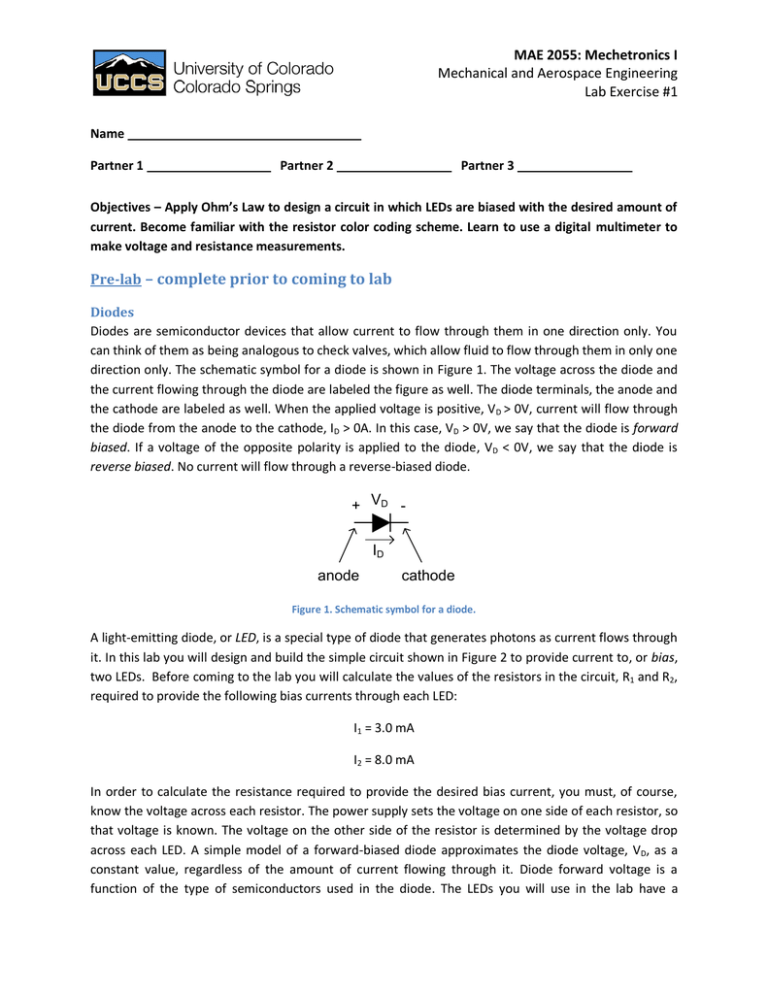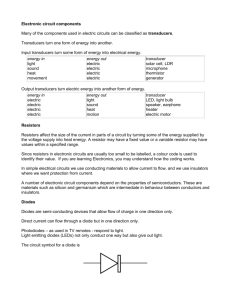MAE 2055: Mechetronics I Mechanical and Aerospace Engineering Lab Exercise #1
advertisement

MAE 2055: Mechetronics I Mechanical and Aerospace Engineering Lab Exercise #1 Name Partner 1 Partner 2 Partner 3 Objectives – Apply Ohm’s Law to design a circuit in which LEDs are biased with the desired amount of current. Become familiar with the resistor color coding scheme. Learn to use a digital multimeter to make voltage and resistance measurements. Pre-lab – complete prior to coming to lab Diodes Diodes are semiconductor devices that allow current to flow through them in one direction only. You can think of them as being analogous to check valves, which allow fluid to flow through them in only one direction only. The schematic symbol for a diode is shown in Figure 1. The voltage across the diode and the current flowing through the diode are labeled the figure as well. The diode terminals, the anode and the cathode are labeled as well. When the applied voltage is positive, V D > 0V, current will flow through the diode from the anode to the cathode, ID > 0A. In this case, VD > 0V, we say that the diode is forward biased. If a voltage of the opposite polarity is applied to the diode, VD < 0V, we say that the diode is reverse biased. No current will flow through a reverse-biased diode. + VD ID anode cathode Figure 1. Schematic symbol for a diode. A light-emitting diode, or LED, is a special type of diode that generates photons as current flows through it. In this lab you will design and build the simple circuit shown in Figure 2 to provide current to, or bias, two LEDs. Before coming to the lab you will calculate the values of the resistors in the circuit, R1 and R2, required to provide the following bias currents through each LED: I1 = 3.0 mA I2 = 8.0 mA In order to calculate the resistance required to provide the desired bias current, you must, of course, know the voltage across each resistor. The power supply sets the voltage on one side of each resistor, so that voltage is known. The voltage on the other side of the resistor is determined by the voltage drop across each LED. A simple model of a forward-biased diode approximates the diode voltage, VD, as a constant value, regardless of the amount of current flowing through it. Diode forward voltage is a function of the type of semiconductors used in the diode. The LEDs you will use in the lab have a MAE2055 Mechetronics I Lab Exercise #1 forward voltage in the neighborhood of 1.9 – 2.0V. For your calculations you may use the approximation that VD = 2.0V. (This voltage will depend on the color of the LED. You’ll use the red LEDs in the lab.) R1 R2 I2 + VD2 - D2 I1 10V + VD1 - D1 Figure 2. Circuit to bias two LEDs. 1. Calculate the exact resistor values required to provide the desired bias currents. Show your calculations. R1 = R2 = Standard resistor values When you calculate the values of the resistance required in a particular circuit, you may come up with a value such as 3861Ω, for example. However, when you go to build your circuit in the lab you’ll find that only certain resistor values are available, and that there is no single resistor whose value is 3861Ω. Discrete resistors are made in standard values. If the resistance you calculate is required for a particular circuit is not one of the standard resistor values, you have two choices: use the closest standard-valued resistor to the desired resistance, or use a series and/or parallel combination of multiple standardvalued resistors to get closer to the desired value. For this lab, you will simply choose the standardvalued resistor that gets you closest to the calculated resistance value. The spacing of the standard resistor values depends on the tolerance of the resistors. The standard values for ±5% resistors are given in Table 1. The standard values of more accurate resistors (e.g. ±2% or ±1%) would be more closely spaced, and those of less accurate resistors (e.g. ±10%) will be spaced further apart. The values in Table 1 are base values that are multiplied by powers of ten. For example, the value 18Ω listed in the table represents resistor values of 18Ω, 180Ω, 1.8KΩ, 18KΩ, and so on. -2- MAE2055 Mechetronics I Lab Exercise #1 Table 1. Standard resistor values for ±5% resistors. 10 Ω 11 Ω 12 Ω 13 Ω 15 Ω 16 Ω 18 Ω 20 Ω 22 Ω 24 Ω 27 Ω 30 Ω 33 Ω 36 Ω 39 Ω 43 Ω 47 Ω 51 Ω 56 Ω 62 Ω 68 Ω 75 Ω 82 Ω 91 Ω 2. Select the closest standard-valued resistors for R1 and R2. R1 = R2 = 3. Calculate the bias currents, I1 and I2, that result when using the standard-valued resistors. Show your calculations below. (Again, assume that VD1 = VD2 = 2.0V.) I1 = I2 = Resistor color coding Resistors are relatively small components, so it would be impractical to print the resistance and tolerance values on the resistor. Instead, a color coding scheme is used to label each resistor with its nominal value and tolerance using colored bands. The color coding scheme is described in Figure 3. Most of the resistors available for use in the lab will use the four-band color code system. So, for example, a 4.7KΩ ±5% resistor, labeled with a four-band color code would have the following bands: yellow, violet, red, gold. 4. Assuming the resistors available in the lab are ±5% tolerance, what are the four-band color codes for R1 and R2? R1 : R2 : -3- MAE2055 Mechetronics I Lab Exercise #1 Figure 3. Resistor color coding scheme. (from www.elexp.com) Prototype boards When you come to the lab, you’ll be building the circuit shown in Figure 1, using the resistor values you have selected. You will build your circuits on a prototyping board (or breadboard) similar to the one shown in Figure 4. The leads of the components, as well as ends of pieces of wire, fit into the holes on the breadboard, where they make electrical connection to internal metal conductors. The conductors inside the breadboard make electrical connections between sets of holes, creating multi-holed electrical nodes. A few of these nodes are shown in Figure 4, and the internal construction of the board is detailed in Figure 5. Note that groups of five holes on either side of the centerline of the board are connected together, but that those connections do not cross the centerline. Also note that entire rows of holes along either long edge of the board (two rows on either side) are all connected together. These rows are useful as power supply buses. That is, they can be used to supply power to many points in a circuit. A power supply voltage can be connected through a wire to one end of the row, and any point in the circuit that makes use of that supply voltage can connect to any hole along that row. The 10V power supply in your circuit will be provided by a bench-top power supply that you will wire to your breadboards. You can make the connection between the power supply and the board with either long pieces of wire or, preferably, with a coaxial cable fitted with alligator clips at one end, which will then connect to your board through short pieces of wire. -4- MAE2055 Mechetronics I Lab Exercise #1 These rows/columns each provide a single electrical connection. (i.e. they are internally connected together.) Figure 4. Breadboard used for prototyping in the lab. Sets of internally-connected nodes are shown. Figure 5. A view of the internal connections of the breadboards. (from www.doctronics.co.uk/prototyp.htm) ---------------------------------- End of the pre-lab ---------------------------------Have your instructor initial here to verify completion of the pre-lab. -5- MAE2055 Mechetronics I Lab Exercise #1 ---------------------------------- To be completed in the lab ---------------------------------5. Gather the components required to build you circuit: LEDs, resistors, any necessary wire, and some means of connecting the power supply to your board. You will also need a set of probes for the digital multimeter (DMM) at your station. You will use the DMM for voltage and resistance measurements. 6. Using the DMM, measure the values of your resistors. They may differ slightly from their nominal values, but should be within the specified tolerance. Record the measured values here and compute the percent error for each resistor. Resistor Nominal Measured % Error R1 R2 7. Build the circuit on your breadboard. Remember that diodes are directional devices. The cathode, or negative terminal, of the LED is indicated by the shorter of the two leads. You may want to try connecting the LED in your circuit in both directions to observe what happens. 8. When calculating resistor values for your circuit, you made the assumption that V D1 = VD2 =2.0V. Check the validity of that assumption by measuring the voltage across each diode. VD1 = VD2 = -6- MAE2055 Mechetronics I Lab Exercise #1 9. Measure the voltage across each resistor, VR1 and VR2, and use those values along with the measured resistance values to calculate the current through each resistor and LED. Show your calculations. VR1 = VR2 = I1 = I2 = 10. How much power is dissipated in each diode? Show your calculations. PLED1 = PLED2 = 11. Does the difference in power dissipation between the two LEDs produce a noticeable result? -7-







